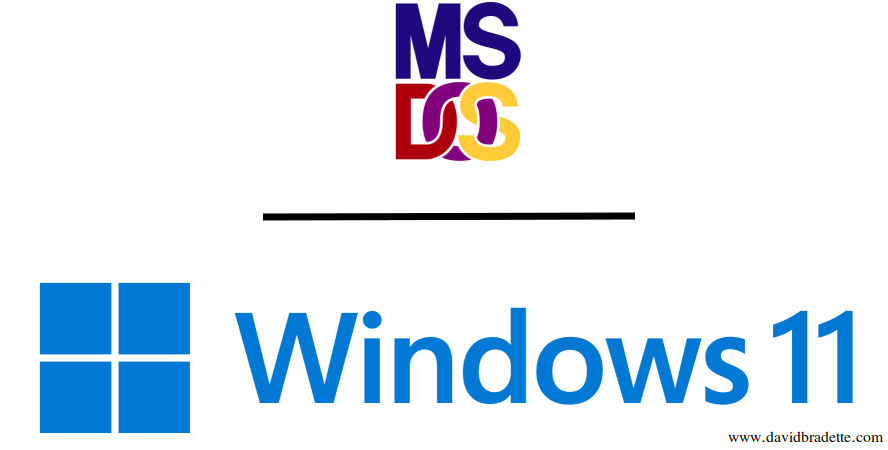From DOS to Windows 11 - A Microsoft MVP's Journey through the Windows Evolution
Being in IT for over two decades, and being a Windows Insider, and Microsoft MVP, I've had the privilege of witnessing and actively participating in the evolution of Windows over the decades. From my early days as a curious youngster tinkering with computers running DOS and Windows 1.0 to my ongoing involvement in beta testing and the Windows Insider Program, my journey has been one of excitement, growth, and adaptation. In this article, I would like to share my unique perspective on the Windows operating system, highlighting key milestones, memorable moments, and my personal favorites.
DOS to Windows 1.0: The Foundation of Modern Computing: My journey with Windows began with DOS, an operating system that laid the groundwork for the Windows ecosystem. As Windows 1.0 emerged, it introduced a graphical user interface (GUI), bringing a more intuitive and user-friendly experience to personal computers. This significant leap marked the transition from command-line interfaces to a visual environment, setting the stage for future innovations.
Windows 95: A Game-Changer: Reflecting on my journey, I vividly recall the release of Windows 95. It was a monumental shift, bringing a user-friendly interface, plug-and-play functionality, and significant improvements to stability and performance. Windows 95 revolutionized the computing landscape, and its impact can still be felt today. This release sparked my excitement for each subsequent Windows iteration.
Windows 98: Embracing Enhanced User Experience and Connectivity: Windows 98 was a significant release that built upon the success of Windows 95. Introduced in 1998, it focused on enhancing the user experience and improving connectivity. With the introduction of the Internet Explorer 4 web browser integrated into the operating system, users could easily access the World Wide Web. Windows 98 also brought essential features like the "Quick Launch" toolbar, support for Universal Serial Bus (USB) devices, and improved hardware and software compatibility. Its improved stability and performance made it a popular choice among users, contributing to its widespread adoption during the late 1990s. Windows 98 was a stepping stone that bridged the gap between the early versions of Windows and the more modern and stable releases that followed.
Windows Millennium: A Learning Experience: Windows Millennium (Me) was a release that brought mixed feelings. While it introduced some new features and enhancements, it faced criticism for its instability and compatibility issues. It served as a learning experience for Microsoft, highlighting the importance of reliability and user feedback in shaping future releases. Though Windows Millennium had its challenges, it reminded us that the journey of an operating system is one of continuous improvement.
Windows XP: A New Era of Productivity and Stability: Windows XP ushered in a new era of productivity and stability. With its refined interface, enhanced performance, and robust features, Windows XP quickly became a favorite among users. It introduced notable advancements, including the iconic Start menu, Windows Explorer enhancements, and improved compatibility. Windows XP remains one of the most beloved and long-lasting Windows versions.
Windows Vista: Striving for Innovation: Windows Vista aimed to push the boundaries of innovation with its modernized interface, improved security features, and enhanced visual effects. While it introduced several advancements, including Windows Aero and User Account Control, it faced criticism for its demanding hardware requirements and initial compatibility issues. However, it served as a stepping stone for future releases, laying the groundwork for the improved experiences to come.
Windows 7: Striking the Perfect Balance: Windows 7 struck the perfect balance between usability and innovation. Building upon the foundation of Windows Vista, it delivered enhanced performance, improved security features, and a streamlined user experience. Windows 7 gained popularity for its stability, intuitive interface, and compatibility, making it a go-to choice for many users and businesses.
Windows 8: Embracing a New Paradigm: Windows 8 marked a significant departure from previous versions with its touch-centric interface and the introduction of the Windows Store. While the bold changes aimed to cater to emerging touch-based devices, the transition proved challenging for some traditional desktop users. Microsoft later responded to user feedback and made refinements in Windows 8.1 to address concerns and improve the overall user experience.
Windows 10: A Versatile and Feature-Rich Ecosystem: As the Windows ecosystem matured, Windows 10 emerged as a versatile and feature-rich operating system. Its familiarity, extensive compatibility, and continuous updates have made it my go-to choice for both personal and professional use. Windows 10 introduced a range of improvements, including the virtual assistant Cortana, the Microsoft Store, and the Universal Windows Platform, empowering developers and users alike.
Windows 11: Embracing the Future of Computing: We now have Windows 11—a new chapter in the Windows journey. With its sleek design, enhanced productivity features, and improved performance, Windows 11 promises to deliver a seamless transition into the future of computing. From the centered Start menu to the revamped taskbar and the integration of Microsoft Teams, Windows 11 presents an exciting evolution of the Windows experience.
Conclusion: My journey with Windows as a Microsoft MVP has been a remarkable one, spanning multiple decades of innovation and transformation. From the humble beginnings of DOS and Windows 1.0 to the challenges faced with releases like Windows Millennium and Vista, and the successes of Windows XP, 7, and 10, each version has brought its own set of advancements and lessons. Through it all, my passion for technology and my connection with the Windows community have remained unwavering. As we continue to embrace new releases, I am confident that Microsoft's dedication to empowering users and fostering collaboration will ensure a bright future for Windows and its users worldwide.







